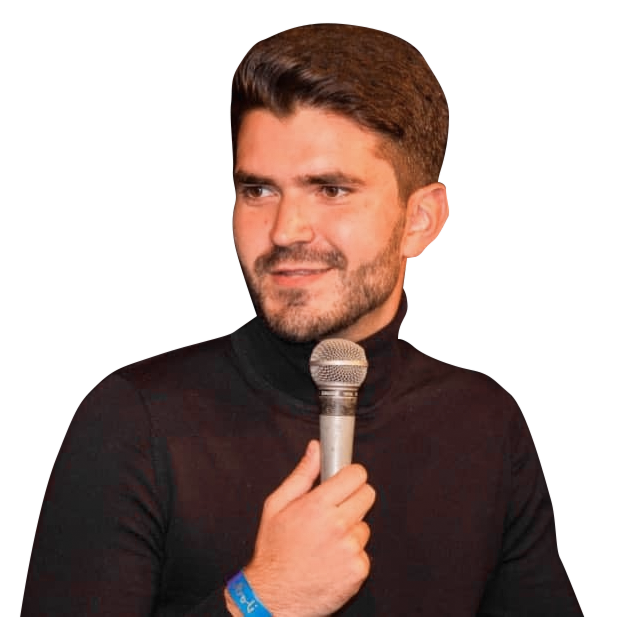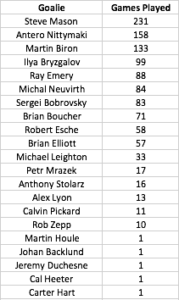
There’s a long-running gag in hockey circles about goalies being voodoo. Part of it is intentionally facetious, usually said with tongue firmly embedded in cheek. But part of it is also born out from a place of frustration, because at the root of it is some undeniable truth that we just can’t seem to shake.
For as much as our collective understanding of the sport and how to evaluate true talent has grown by leaps and bounds over the past handful of years, the biggest gap in knowledge that still persists is the one that resides between the pipes at both ends of the ice. And it’s not because of a lack of effort, either, because there’s been plenty of important work done in the public sphere.
By poking and prodding at the puzzle, we’ve certainly made some strides. We’ve largely moved away from using former staple metrics like wins and goals against average when describing an individual goaltender’s performance. We’ve also peeled back a couple of layers to better account for a netminder’s circumstances – looking beyond just raw save percentage to account for contextual factors such as a) how many shots a goalie is facing, b) where they’re coming from, c) who’s taking them, and d) at what state all of it is happening. By using Goals Saved Above Average (GSAA), we can more fairly evaluate how good a goalie has been at stopping pucks based on the situation they’ve been thrown into.
The issue is that while we’ve methodically become better at describing what’s already happened, trying to predict future performance of goalies remains something of a wild goose chase at times. The volatility at the position from year to year tends to be a nauseating rollercoaster ride, making the sustained excellence of the gold standard Henrik Lundqvist all the more admirable. The reality is that he’s the exception that proves the rule, because otherwise the only thing predictable about the landscape is that it’s constantly changing.
The goaltending position is one that’s tough to be good at to begin with, and one that’s in some ways even tougher to remain good at once you’re already there. If you take a look around the league this year, you’ll see that it’s one that’s littered with examples of goalies that have recently either dramatically declined, or come out of essentially nowhere to post sparkling numbers that no one could’ve anticipated.
It wasn’t that long ago that Cory Schneider was considered the model of consistency at the position, essentially being penciled in for something between a .920 and .925 save percentage at the start of each year. Injuries have obviously played a role, but in the past three years he’s dipped from .908, to .907, all the way down to .852 this year. It’s been nearly a full calendar year since his last win, and it’s becoming fair to wonder whether he’s now just simply done at only 32 years old.
His story pales into comparison to that of Carey Price, who has seemingly gone from best goalie in the league to cautionary tale in the blink of an eye. Spanning 2013-2017, Price appeared in nearly 200 total games, stopping nearly 93% (.928 to be exact) of the shots he faced. He finished 1st, 3rd, and 4th in Vezina voting in the three healthy seasons he put together during that time. He’s now in the midst of his second consecutive year of being a .900 goalie, having surrendered a league-worst 11 goals more than a league average netminder would’ve in his spot. The most alarming part is that he’s currently only in his 1st year of an 8-year, $84 million deal that could potentially be disastrous if this is the new norm for him.
On the other end of the spectrum, we’ve seen some highly unlikely names emerge to give their respective teams quality starts this season. In the top 10 of goals saved above average you’ll find David Rittich, Mikko Koskinen, and Casey DeSmith, all of whom have over time wrestled away the starting gig from the incumbent that was in place to start the year.
Rittich is a 26-year old who was an undrafted goalie playing in the relatively unheralded Czech league just three seasons ago, and had an .889 save percentage in the AHL just last year. DeSmith came into the campaign with a more established pedigree across the NCAA and AHL, but he’s also turning 28 this summer and came into the season with just 11 NHL starts under his belt. Koskinen was solid in the second best pro league in the world for years, but he was playing for a great team, and it had been 8 years since his last equally brief and underwhelming stint in North America. Considering Cam Talbot’s continued struggles, he’s been near the top of the non-Connor McDavid division for reasons the Oilers have managed to salvage their season after a shaky start.
With how truly volatile the goalie position has proven to be, all of those wild swings in performance from one extreme to the other have made for very few consistent trends that have held themselves over the years. Which has only further highlighted the unintentional comedy of the repeated efforts by the Philadelphia Flyers organization to find themselves a reliable puck-stopper in that time. They’ve swung and missed in such glorious fashion so many times in a row now, that their failed attempts to find a goalie have in a morbidly comforting way become one of those very few things we’ve been able to bank on at the position.
To put it in perspective, here’s the full list of goalies they’ve used in net since Henrik Lundqvist made his debut for the division rival Rangers back in 2005:

That’s 21 different goalies in 14 years that have made an appearance for the Flyers, and considering the volume of throwback names it’s not surprising that they’ve exhausted nearly every avenue in their search. There’s a gamut of journeymen that bounced around the league before landing in Philadelphia, but there’s also high-priced free agents, young prospects they drafted themselves, and former highly regarded names that burned out in their initial stops that they figured they’d take a chance on.
The ones that stings in particular is Sergei Bobrovsky, considering the career he’s gone on to have since leaving the Flyers. It’s impossible to know how things would’ve gone for him had he stayed, and it’s unfair to suggest that there were tangible signs that he’d reach the heights that he did in Columbus, but it hurts nonetheless to have traded away a player that went on to win the Vezina the following year while still playing on his entry level deal (and another one a few years later) for a couple of largely inconsequential draft picks.
Especially since there hasn’t been a single name that’s come remotely close to replicating his performance in a Flyers uniform since. Aside from a couple of surprisingly strong Steve Mason seasons – particularly at even strength, before he ultimately came back down to earth – the goalie carousel has continued to spin around in Philadelphia.
Its seemingly hit its nadir this season, with the team having burned through a record number of options in net in just the first two months alone. Considering the names its involved it’s not exactly surprising that they’ve bottomed out as arguably the worst unit in the league, after years of ranging between mediocre and downright bad.

Given how bleak things have gotten in Philadelphia, it’s also not at all surprising that both the coach and general manager were ultimately fired, and that they’ve somewhat begrudgingly given in to the fervent calls for their top goalie prospect to finally get a look at the NHL level.
It’ll be rather fascinating to see how Carter Hart responds to the challenge. Whether it’s been entirely warranted or not, teams have historically been especially conservative with how they’ve handled young goalies, with the list of names that have been given a substantial number of NHL starts before their 21st birthday being quite short.
But just because the previous track record for goalies immediately jumping in and thriving at this age hasn’t been extensive, doesn’t preclude Hart from doing it himself and breaking that trend. With teams embracing the youth movement more and more when it comes to skaters, there’s no reason to believe that there won’t eventually similarly be a trickledown to goalies as well and the way they’re developed.
If anyone can break through and start the new trend, Hart himself seems like a particularly good candidate to do so. Even though this is an entirely different animal, he’s checked all of the performance indicators he’s been able to along the way. He was the Western Hockey League’s top goaltender three times, the entire Canadian Hockey League’s top goaltender twice, and backstopped Team Canada to Gold at last year’s World Junior Championship. By all accounts, he’s long been considered to be one of the best goalies currently not playing in the NHL, and with good reason.
Hart’s debut, a home start against a feeble Red Wings team on Tuesday night, was a cushy landing spot for him to start things off in and he took advantage of it by getting a win under his belt. Things will presumably get trickier moving forward, as he navigates both a new league and an unfavourable precedent.
Their hand may’ve been forced into realizing it sooner than they were initially expecting to, but the future has arrived in Philadelphia. And it honestly couldn’t have come soon enough. The Flyers have pined for a long-term solution in net more than anyone, and they appear to have mercifully found one in Carter Hart at long last.
How he holds up against the mountain of pressure that’s being placed in front of him ultimately remains to be seen, but for now he at least represents some much needed hope. Hope that he can not only put a temporary pause to the dizzying goalie carousel in Philadelphia, but hope that he can be the one to finally put a stop to it for good.
The data in this piece is courtesy of Corsica, Natural Stat Trick, Hockey Reference, and of course the mothership Elite Prospects itself.

